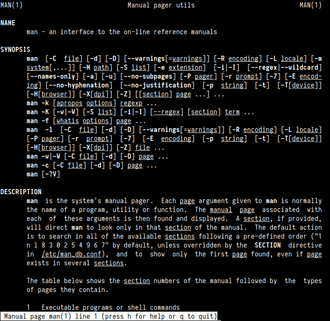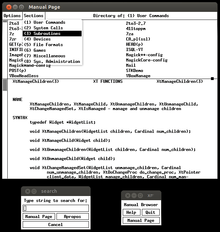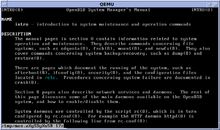man page

A man page (short for manual page) is a form of software documentation usually found on a Unix or Unix-like operating system. Topics covered include computer programs (including library and system calls), formal standards and conventions, and even abstract concepts. A user may invoke a man page by issuing the man command.
By default, man typically uses a terminal pager program such as more or less to display its output.
Usage
To read a manual page for a Unix command, a user can type:
man <command_name>
Pages are traditionally referred to using the notation "name(section)": for example, . The same page name may appear in more than one section of the manual, such as when the names of system calls, user commands, or macro packages coincide. Examples are and , or and . The syntax for accessing the non-default manual section varies between different man implementations.
On Solaris and illumos, for example, the syntax for reading is:
man -s 3c printf
On Linux and BSD derivatives the same invocation would be:
man 3 printf
which searches for printf in section 3 of the man pages.
History


In the first two years of the history of Unix, no documentation existed.[1] The Unix Programmer's Manual was first published on November 3, 1971. The first actual man pages were written by Dennis Ritchie and Ken Thompson at the insistence of their manager Doug McIlroy in 1971. Aside from the man pages, the Programmer's Manual also accumulated a set of short papers, some of them tutorials (e.g. for general Unix usage, the C programming language, and tools such as Yacc), and others more detailed descriptions of operating system features. The printed version of the manual initially fit into a single binder, but as of PWB/UNIX and the 7th Edition of Research Unix, it was split into two volumes with the printed man pages forming Volume 1.[2]
Later versions of the documentation imitated the first man pages' terseness. Ritchie added a "How to get started" section to the Third Edition introduction, and Lorinda Cherry provided the "Purple Card" pocket reference for the Sixth and Seventh Editions.[1] Versions of the software were named after the revision of the manual; the seventh edition of the Unix Programmer's Manual, for example, came with the 7th Edition or Version 7 of Unix.[3]
For the Fourth Edition the man pages were formatted using the troff typesetting package[1] and its set of -man macros (which were completely revised between the Sixth and Seventh Editions of the Manual,[2] but have since not drastically changed). At the time, the availability of online documentation through the manual page system was regarded as a great advance. To this day, virtually every Unix command line application comes with a man page, and many Unix users perceive a program's lack of man pages as a sign of low quality; indeed, some projects, such as Debian, go out of their way to write man pages for programs lacking one. The modern descendants of 4.4BSD also distribute man pages as one of the primary forms of system documentation (having replaced the old -man macros with the newer -mdoc).
Few alternatives to man have enjoyed much popularity, with the possible exception of GNU Project's "info" system, an early and simple hypertext system.
In addition, some Unix GUI applications (particularly those built using the GNOME and KDE development environments) now provide end-user documentation in HTML and include embedded HTML viewers such as yelp for reading the help within the application.
Man pages are usually written in English, but translations into other languages may be available on the system.
The default format of the man pages is troff, with either the macro package man (appearance oriented) or mdoc (semantic oriented). This makes it possible to typeset a man page into PostScript, PDF, and various other formats for viewing or printing.
Most Unix systems have a package for the man2html command, which enables users to browse their man pages using an html browser (textproc/man2html on FreeBSD or man on some Linux distribution).
In 2010, OpenBSD deprecated troff for formatting manpages in favour of mandoc, a specialised compiler/formatter for manpages with native support for output in PostScript, HTML, XHTML, and the terminal.
In February 2013, the BSD community saw a new open source mdoc.su service launched, which unified and shortened access to the man.cgi scripts of the major modern BSD projects through a unique nginx-based deterministic URL shortening service for the *BSD man pages.[4][5][6]
Manual sections
The manual is generally split into eight numbered sections, organized as follows (on Research Unix, BSD, OS X and Linux):
| Section | Description |
|---|---|
| 1 | General commands |
| 2 | System calls |
| 3 | Library functions, covering in particular the C standard library |
| 4 | Special files (usually devices, those found in /dev) and drivers |
| 5 | File formats and conventions |
| 6 | Games and screensavers |
| 7 | Miscellanea |
| 8 | System administration commands and daemons |
Unix System V uses a similar numbering scheme, except in a different order:
| Section | Description |
|---|---|
| 1 | General commands |
| 1M | System administration commands and daemons |
| 2 | System calls |
| 3 | C library functions |
| 4 | File formats and conventions |
| 5 | Miscellanea |
| 6 | Games and screensavers |
| 7 | Special files (usually devices, those found in /dev) and drivers |
On some systems some of the following sections are available:
| Section | Description |
|---|---|
| 0 | C library header files |
| 9 | Kernel routines |
| n | Tcl/Tk keywords |
| x | The X Window System |
Some sections are further subdivided by means of a suffix; for example, in some systems, section 3C is for C library calls, 3M is for the math library, and so on. A consequence of this is that section 8 (system administration commands) is sometimes relegated to the 1M subsection of the main commands section. Some subsection suffixes have a general meaning across sections:
| Subsection | Description |
|---|---|
| p | POSIX specifications |
| x | X Window System documentation |
Some versions of man cache the formatted versions of the last several pages viewed.
Layout
All man pages follow a common layout that is optimized for presentation on a simple ASCII text display, possibly without any form of highlighting or font control. Sections present may include:
- NAME
- The name of the command or function, followed by a one-line description of what it does.
- SYNOPSIS
- In the case of a command, a formal description of how to run it and what command line options it takes. For program functions, a list of the parameters the function takes and which header file contains its definition.
- DESCRIPTION
- A textual description of the functioning of the command or function.
- EXAMPLES
- Some examples of common usage.
- SEE ALSO
- A list of related commands or functions.
Other sections may be present, but these are not well standardized across man pages. Common examples include: OPTIONS, EXIT STATUS, ENVIRONMENT, BUGS, FILES, AUTHOR, REPORTING BUGS, HISTORY and COPYRIGHT.
See also
- List of Unix utilities
- List of Plan 9 applications
- Info (Unix)
- RTFM
- ManOpen - NeXT/OS X graphical man utility
References
- 1 2 3 McIlroy, M. D. (1987). A Research Unix reader: annotated excerpts from the Programmer's Manual, 1971–1986 (PDF) (Technical report). CSTR. Bell Labs. 139.
- 1 2 Darwin, Ian; Collyer, Geoffrey. "UNIX Evolution: 1975-1984 Part I - Diversity". Retrieved 22 December 2012. Originally published in Microsystems 5(11), November 1984.
- ↑ Fiedler, Ryan (October 1983). "The Unix Tutorial / Part 3: Unix in the Microcomputer Marketplace". BYTE. p. 132. Retrieved 30 January 2015.
- ↑ Pali, Gabor, ed. (12 May 2013). "FreeBSD Quarterly Status Report, January-March 2013". FreeBSD. Retrieved 25 December 2014.
- ↑ Murenin, Constantine A. (19 February 2013). "announcing mdoc.su, short manual page URLs". freebsd-doc@freebsd.org (Mailing list). Retrieved 25 December 2014.
- ↑ Murenin, Constantine A. (23 February 2013). "mdoc.su — Short manual page URLs for FreeBSD, OpenBSD, NetBSD and DragonFly BSD". Retrieved 25 December 2014.
External links
- History of UNIX Manpages for a primary-source history of UNIX manpages.
This article is based on material taken from the Free On-line Dictionary of Computing prior to 1 November 2008 and incorporated under the "relicensing" terms of the GFDL, version 1.3 or later.